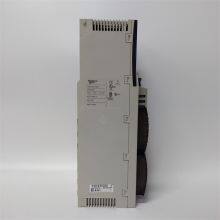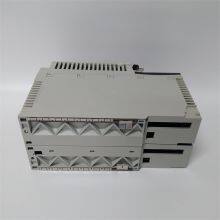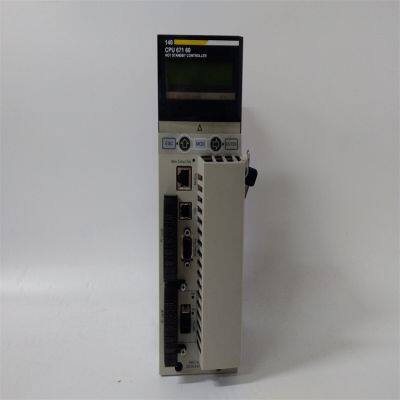Functional Features Programming Support: It can be programmed using Unity Pro software. Legacy applications can be simply imported, and the legacy 984 ladder logic programs are supported in the LL984 Unity Pro editor. It also supports application software such as "Concept..." and "PROWERX..." 32 application software. Safety Certification: The PLC provides safety applications certified for SIL3 applications, including standard and hot standby capabilities as well as redundant I/O, which is suitable for occasions with high safety requirements. Task Processing: It has a multitasking processing system, which can handle multiple tasks and functions simultaneously, improving the operation efficiency and response speed of the system. Communication Capability: It supports multiple communication protocols and is equipped with multiple built-in ports, enabling convenient communication and data interaction with other devices and systems, and realizing the integration and expansion of the system.
Application Fields Manufacturing Industry: It is suitable for automated production lines in industries such as automobile manufacturing and mechanical processing. It can achieve precise control and monitoring of production equipment, improving production efficiency and product quality. For example, on an automobile assembly line, it can control the movement of robotic arms, the transportation of components, etc. Energy Industry: It can be used in places such as power plants and substations. In power plants, it can monitor and control the operating parameters of generator sets to ensure the stability of the power generation process. In substations, it can monitor and control the status of power equipment to ensure the safe and reliable transmission of electricity. Transportation Industry: For example, in rail transit, it can be used to control the signal system, automatic ticketing system, etc. In ports, it can control loading and unloading equipment such as cranes and conveyor belts to achieve efficient loading and unloading of goods. Water Treatment Industry: It can be applied to waterworks and sewage treatment plants. In waterworks, it can control equipment such as the chemical dosing system and water pumps in the water treatment process. In sewage treatment plants, it can control the aeration system, sludge treatment system, etc. to ensure the water treatment effect.
Common Faults and Corresponding Solutions: Power Supply Fault Fault Phenomenon: The indicator light of the CPU module does not light up, and it cannot be started normally. Possible Causes: Abnormal external power supply, such as unstable voltage or power outage; Damage to the power supply module; Loose or damaged power connection cable. Solutions: Use a multimeter to measure the external power input voltage to confirm whether it is within the voltage range specified by the module (generally around 24V DC). If the voltage is abnormal, check the power supply equipment and circuit; Check the power supply module to see if there are obvious signs of damage, such as charring, strange smell, etc. If there is a problem, replace the power supply module; Check the power connection cable to ensure that the connection is secure, and there is no damage or open circuit. Replace the cable if necessary. Communication Fault Fault Phenomenon: It is unable to communicate with other devices (such as HMI, remote I/O modules, etc.), and the communication indicator light is abnormal (such as not lighting up or flashing at an abnormal frequency). Possible Causes: Incorrect or loose connection of the communication cable; Incorrect setting of communication parameters, such as baud rate, address, protocol, etc.; Damage to the communication interface; Fault of network equipment (such as a switch). Solutions: Check the connection of the communication cable to ensure that it is correct and secure. You can try reinserting it; Check the communication parameter settings and compare them with the parameters of the connected device to ensure consistency. If they are inconsistent, reset them; Check the communication interface to see if there is physical damage, such as bent pins or oxidation. If there is damage, repair or replace it; Check the working status of network equipment, such as a switch, to see if there are problems such as port faults or configuration errors. You can try restarting the switch or changing the port.
Program Operation Fault Fault Phenomenon: The program cannot run normally, and situations such as freezing, loop errors, or abnormal output results occur. Possible Causes: Program logic errors; Insufficient memory; The firmware version of the CPU module is too low, and there are software vulnerabilities. Solutions: Use programming software (such as Unity Pro) to check the program logic, find and fix the errors; Check the memory space occupied by the program, optimize the program code, and release unnecessary memory resources; Query Schneider's official website to obtain the latest firmware version of the CPU module and update it according to the instructions. I/O Module Fault Fault Phenomenon: The input signal cannot be read by the CPU module, or the output signal cannot correctly drive the external device, and the indicator light of the I/O module is abnormal. Possible Causes: Damage to the I/O module; Fault of the I/O connection cable; Incorrect setting of the I/O address. Solutions: Replace the faulty I/O module; Check the I/O connection cable to ensure that the connection is correct and there is no damage. Replace the cable if there is a problem; Check the I/O address setting and compare it with the address used in the program to ensure consistency. If it is inconsistent, reset it. Overheating Fault Fault Phenomenon: The surface temperature of the CPU module is too high, which may trigger the overheating protection, resulting in a decline in the module's performance or its shutdown. Possible Causes: Poor ventilation in the installation environment; Serious dust accumulation on the module's heat sink; Long-term high-load operation. Solutions: Improve the ventilation conditions of the installation environment to ensure that there is enough space around the module for heat dissipation. Install a cooling fan if necessary; Regularly clean the dust on the module's heat sink to maintain good heat dissipation performance; Optimize the program, allocate tasks reasonably, and avoid long-term high-load operation of the module. Battery Fault (for data storage) Fault Phenomenon: It prompts that the battery level is low or data is lost, which may affect the saving of programs and settings. Possible Causes: The battery is depleted; Poor battery contact. Solutions: Replace the battery with a new one to ensure that the battery model is correct; Check the battery installation position to ensure that the battery makes good contact and there is no looseness or oxidation.

Send Inquiry to This Supplier
You May Also Like
-
CI854AK01 3BSE030220R1 Communication ModuleUS$ 200 - 1400MOQ: 1 Unit
-
UFC760BE41 3BHE004573R0041 Control ModuleUS$ 300 - 2200MOQ: 1 Unit
-
GE IS230SNCIH6A Digital Input ModuleUS$ 200 - 2400MOQ: 1 Unit
-
ABB 5SHY3545L0009 3BHB013085R0001 IGCT ModuleUS$ 11000 - 15500MOQ: 1 Unit
-
PFSK152 3BSE018877R2 Signal Processor ModuleUS$ 350 - 2100MOQ: 1 Unit
-
PM864AK01 3BSE018161R1 Processor UnitUS$ 2600 - 7540MOQ: 1 Unit
-
PM866K01 3BSE050198R1 Processor UnitUS$ 2560 - 7840MOQ: 1 Unit
-
PM860K01 3BSE018100R1 Processor Unit KitUS$ 1390 - 4600MOQ: 1 Unit
-
5SHY3545L0014 3BHE023784R0001 IGCT Thyristor ModuleUS$ 2600 - 5100MOQ: 1 Unit
-
5SHX1445H0001 3BHL000391P0101 IGCT ModuleUS$ 1680 - 3570MOQ: 1 Unit














